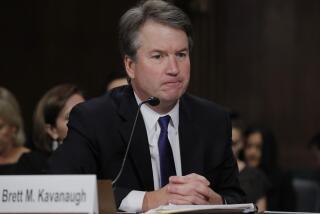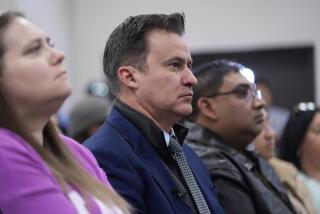Faulty Testimony, Practices Found in FBI Lab Probe
WASHINGTON — FBI crime laboratory experts gave inaccurate testimony at the trials of defendants in the World Trade Center blast and the 1989 bombing of Avianca Flight 203 in Colombia, and lab scientists and technicians used shoddy analysis and did not follow procedures in scores of other cases, the Justice Department’s inspector general concluded Tuesday.
Those findings, coupled with serious problems in the way lab officials conducted themselves in the Oklahoma City bombing and the O.J. Simpson case, are part of a sweeping, 18-month investigation into significant failures at the lab at FBI headquarters in Washington.
The report could have major implications for the trial of Oklahoma City bombing suspect Timothy J. McVeigh because it tends to bolster defense arguments that lab work on key pieces of forensic evidence was compromised. But prosecutors plan to use scientific experts from outside the lab to testify.
In addition to conclusions about how lab officials have performed in court, the inspector general also found that the bureau’s scientists and technicians did not properly document their test results and poorly prepared lab reports.
Reacting quickly to the report, senior FBI management officials accepted responsibility for the failings at their once-unblemished crime lab and also revealed that they have created a special task force to review “hundreds” of past and pending criminal cases that may have been impacted by faulty and sometimes shoddy FBI lab work.
While top federal law enforcement officials expressed confidence that those and other cases will move forward, defense attorneys are expected to seize on the revelations in attempts to exonerate their clients.
In another development Tuesday, both Justice Department and FBI officials pointed out that the vast majority of the hundreds of allegations by the key whistle-blower, lab chemist and FBI agent Frederic Whitehurst were not substantiated.
Among the disproved allegations were Whitehurst’s contentions that some lab examiners purposely shaded their results to help prosecutors, and that some of them knowingly committed perjury. But Inspector General Michael R. Bromwich added that “some important” allegations made by Whitehurst were substantiated, including some related to the Oklahoma City bombing case--in which jury selection is now underway for McVeigh’s trial.
Overall, in investigating work at the lab’s three key sections--the chemistry-toxicology, explosives and materials analysis units--Bromwich said: “We found significant instances of testimonial errors, substandard analytical work and deficient practices.”
Investigators also discovered instances where dictation on lab reports was altered and lab supervisors did not properly manage their agents.
40 Recommendations to Improve Lab
Bromwich and his staff, which included five prominent scientists from outside the federal government, listed 40 recommendations for improving the lab, and the FBI said it had either adopted or would soon be embracing all of them.
Among the key improvements will be a new lab facility at the bureau’s training academy in Quantico, Va., a new lab director from outside the bureau and--for the first time in the lab’s 65-year history--outside accreditation from the American Society of Crime Laboratory Directors.
“This isn’t a pleasant one for me,” FBI Deputy Director William Esposito said of the inspector general’s report. “We regret we got to this point in the FBI.”
But Esposito noted that with the lab conducting tests on 600,000 cases a year, the vast majority of its work was not called into question.
Bromwich stressed Tuesday that his office was never charged with determining whether the criminal justice system was compromised by poor FBI lab work. But he predicted that “there will be challenges” filed by defense attorneys, either to overturn convictions or to throw out pieces of evidence.
“There are many cases that are potentially implicated by the findings,” he said. “We expect to see a lot of motions filed.”
James M. Maddock, the FBI’s inspector deputy general counsel, said the bureau has established a special team to investigate potential problems, and that it is now reviewing “several hundred” past cases.
Potential Problems Cited in 55 Cases
Meanwhile, prosecutors in about 55 pending criminal cases have been notified that there may be potential problems, he said.
In those 55, prosecutors have found it important enough to notify defense attorneys in about 25 cases. Of those, there have since been verdicts for the prosecution in 14, Maddock said, and motions for new trials have been denied.
Regarding the rest, he said, “we are confident we can work with the prosecutors to resolve these issues.”
Bromwich’s report does not say when or why the problems began at the lab, but some of the cases studied date back to the 1980s. As early as 1991, top FBI management was alerted to failures at the lab when it used a highly credited model designed by the ASCLD to identify deficiencies.
Among the cases reviewed by the inspector general:
* The Oklahoma City bombing.
The Alfred P. Murrah Federal Building was destroyed on April 19, 1995, killing 168 people and injuring 500 others.
The inspector general said that the FBI lab’s David Williams “repeatedly” reached conclusions that were in error.
In addition, the explosives unit chief, J. Thomas Thurman, “performed an inadequate review of Williams’ report by allowing Williams too much discretion and by approving conclusions with which Thurman disagreed and could not support.”
The report also concluded that Roger Martz, chief of the lab’s chemistry-toxicology unit, “improperly deviated from the explosives residue protocol in his examination of some specimens.”
Additionally, the inspector general concluded that Williams was unjustified in his opinion about the speed of the bomb, incomplete in his statements about the use of ammonium nitrate and inappropriate in his identification of the main detonation charge.
“These errors were all tilted in such a way as to incriminate the defendants,” the inspector general’s report said.
“We are troubled that the opinions in Williams’ report may have been tailored to conform to the evidence associated with the defendants. We conclude that Williams failed to present an objective, unbiased, competent report.”
The FBI objected to any conclusion that Williams’ opinions were pro-prosecution. As to Thurman, the FBI noted his 27-year FBI career and said he has only “committed a few minor mistakes and one significant managerial error in approving Williams’ report on the Oklahoma City bombing.”
The bureau also took exception to the assertion that Martz “lacks the credibility, judgment and temperament that is essential for a unit chief.” Such a statement, the FBI said, “seems to be an overly broad condemnation.”
* The World Trade Center explosion of Feb. 26, 1993, which killed six people.
Much of the forensic evidence from the blast--particularly as it pertained to the chief defendant, Mohammed A. Salameh--was examined by Williams in the lab’s explosives unit. The militant Muslim was found guilty in 1994 of conspiring to bomb the trade center.
But, the inspector general concluded, “we are profoundly disturbed by Williams’ testimony in the Salameh trial.”
Specifically, Williams “gave inaccurate testimony regarding [Salameh’s] role in the manufacture of urea nitrate and regarding whether the urea nitrate was made pursuant to Arabic formulas from bomb-making books.”
Williams testified “beyond his expertise” and “in a way that made the testimony appear tailored to the most incriminating result,” investigators concluded.
And, the inspector general said, Williams gave incomplete testimony about the velocity of the bomb and invalid and misleading opinions about other details.
The FBI, in its official response to the inspector general’s findings, objected to suggestions that Williams’ testimony appeared to be pro-prosecution. “Williams’ testimony on cross-examination was proper, and none of the inaccuracies criticized by the [inspector general] were significant in the jury’s determination of guilt,” the FBI said.
But Robert Precht, who was Salameh’s defense attorney, noted that since the FBI has known for at least six years of problems at the lab, “this provides powerful ground for arguing for a new trial.”
“It’s possible the FBI withheld important exculpatory evidence from the defense due to these problems in the lab,” Precht said. “And certainly if I had known of these allegations, I would have pursued my cross-examination of FBI witnesses in different ways.”
* The Avianca airplane bombing.
One hundred seven people, including two Americans, died when a bomb exploded aboard Avianca Flight 203 shortly after takeoff on Feb. 27, 1989, from Bogota, Colombia.
Richard Hahn, a lab expert, was assigned to the case as part of a U.S. team. He testified as an explosives expert in two trials of Dandeny Munoz-Mascara in New York. The first ended in a mistrial, the second in conviction.
The inspector general concluded that Hahn committed several errors.
“He erroneously testified in the first trial that no dynamite could have caused the pitting and cratering on the aircraft,” the inspector general said.
The report said Hahn gave expert scientific opinions about the blast that were “unsound and not justified by his experience” and “incomplete results” about some of the lab analyses of the evidence, and that he “testified incorrectly and outside his expertise concerning a fuel-air explosion.”
The lead prosecutor in the case defended Hahn to the inspector general, saying that he was being “unfairly attacked.” And the FBI, in its response, urged unsuccessfully that any suggestion that Hahn was trying to support the prosecution’s theory of the case should be “deleted” from the final report.
* The George Bush assassination plot.
In April 1993, while former President Bush was visiting Kuwait, authorities there arrested 17 people allegedly involved in a plot to kill him using a car bomb. The United States retaliated with a missile strike to Iraq, and a Kuwaiti court convicted all but one of the defendants.
Whitehurst alleged that J. Christopher Ronay, the explosives unit chief, changed or misrepresented Whitehurst’s lab results--a charge that the inspector general discounted. Instead, the inspector general faulted Whitehurst for the way he prepared his chemical analysis reports.
Since Bromwich began his investigation, Williams, Thurman and Martz have been transferred out of the lab. Whitehurst also was moved aside. The FBI said it was leaving it to the Justice Department to advise about Whitehurst’s future.
On Capitol Hill, Sen. Charles E. Grassley (R-Iowa), who chairs a Senate subcommittee on oversight of federal law enforcement, was outraged about how the FBI has conducted itself.
“It seems the FBI chose to protect its image rather than improve its product,” he said. “The moral of this story is senior management at the FBI abdicated its responsibility to the American people [and] more importantly to thousands of honest, hard-working FBI agents around the country.”
Times staff writer Sam Fulwood contributed to this story.
(BEGIN TEXT OF INFOBOX / INFOGRAPHIC)
Lab Results
Principal findings by investigators in the FBI laboratory case:
* Scientifically flawed testimony in four cases, including the World Trade Center bombing.
* Inaccurate testimony by an explosives unit examiner from the lab in the World Trade Center case
* Testimony beyond the examiner’s expertise in the World Trade Center and the 1989 explosion of Avianca Airlines flight 203, in which 107 people on board were killed.
* Insufficient documentation of test results in hundreds of cases, including the hunt for the Unabomber.
* Failures by management to properly supervise lab examiners and their test results.
More to Read
Sign up for Essential California
The most important California stories and recommendations in your inbox every morning.
You may occasionally receive promotional content from the Los Angeles Times.











